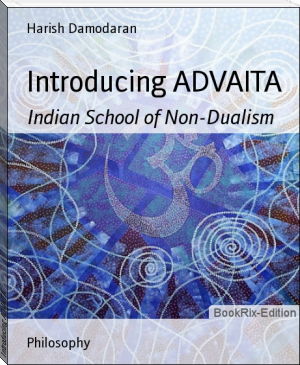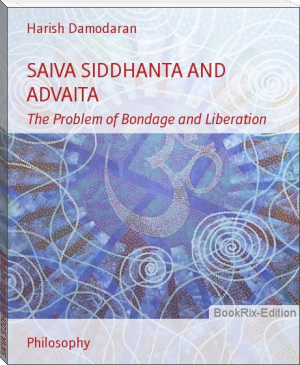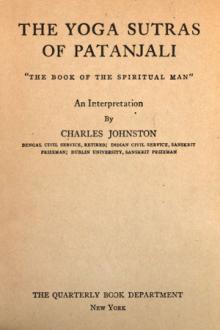Introducing ADVAITA, Harish Damodaran [animal farm read .TXT] 📗

- Author: Harish Damodaran
Book online «Introducing ADVAITA, Harish Damodaran [animal farm read .TXT] 📗». Author Harish Damodaran
The Advaitins have not even the slightest objection to the concept of the nishkama karma. They accept it whole-heartedly. This forms the pragmatic side of the Advaita Vedanta.
Again for those who cannot take up ‘Karmayoga’, the Bhagavat Gita suggests ‘KarmaSanyasa’. That is, through renunciation too, the seeker can find his liberation. This, also, is in tune with the Advaitic View. One who is in the paramarthika level of reality is above and beyond all the Karmas.
The Bhagavat Gita puts forward, the concept of the sthitha prajna. The Sthitha prajna is a man of steady wisdom. He is liberated from the chain of endless karmas. He is the Jivan Mukta upon whom Advaita vedanta showers all its praises.
The picture of the God, Purushotama, as shown by the Bhagavat Gita suits to the Suguna Brahman or Iswara of the Advaita Vedanta. He is the very embodiment of existence, essence and excellence of all the qualities.
Thus, in short the Bhagavat Gita, as a source book, saves the philosophy of Advaita Vedanta from the danger of being other-worldly and self- centred.
This divine song shows the light to follow the right path for the Advaitins. It tells them how to live and how to act. It is the real path to liberation.
Among the secondary sources of the Advaita Vedanta, the Mandukya karika by Sri Gaudapadacharya holds a very high position. Gaudapadacharya is the Guru of the Guru of Sri Sankaracharya and therefore, known as the ‘Parama Guru’.
On the first look, the Mandukya karika is a commentary on the mandukya Upanisad. But, in fact, by writing a commentary on the Mandukya Upanisad. Sri Gaudapadacharya is astablishing the system of Advaita Vedanta.
Sri Gaudapadacharya bases his philosophy on the doctrine of no-origination or ‘ajathi vada’. Through the Mandukya karika (other wise called Gaudapada karika), he establishes the reality of non-dual self.
The Maudukya Upanisad begins with the equation Aum=All=Brahman=Self and proceeds to describe the three states of the self viz; Jagrat (waking), Swapna (Dreaming), Sushupti (deep sleep) and Thuriya (Forth stage). Sri Gaudapadacharya makes this declaration of the Upanisad as the basis of his metaphysical quest and seeks to show through reasoning that no originate is the final truth.
The Gaudapada karika gives clear evidence that Sri Gaudapadacharya is the first systematic exponent of Advaita Vedanta. The central principles of the Advaita school of thought such as orders of reality the identity of the invidual soul (atman) and Brahman the concept of Maya the inapplicability of causation to the ultimate reality and Jnana as the direct means to Moksa are all set forth in the Mandukya karika.
However, the negative tendency is more prominent in his view, since it is in close resemblance with a kind of sunyadava (Nihilsam). Although it is not as balanced as Sri Sankaracharya’s view, its importance as an attempt to combine in one whole the negative logic of Madhyamika Buddhism with the positive idealism of the Upanishadic thought can not be ignored. Sri Gaudapadacharya is liable to the change of subjectivism in the traditional sense since he uses the arguments, which the Buddhistic VijnAnavadins employed to prove the unreality of the external objects of perception.
The Mandukya karika explains the doctrine of Maya as the inexplicability of the relation between Atman and the world, the nature or power of Isvara and the apparent dream like appearance of the world. Of these three the first one has been later taken by Sri Sankaracharya and given great prominence in order to develop the school of Advaita into its present form.
The term ‘Advaita’ simply means ‘non-dual’ or ‘not two’. In other words, plainly speaking, the absolute self, the Brahman and the individual self, Jiva are not two. By using the term 'Advaita', it can be said that the scholars prefer to indirectly imply the Unity of the Brahman and the Jiva, rather than stating it directly. Therefore, Advaitins do not directly say that the Jiva and Brahman are one and the same, but say that both are not different from each other.
Chapter 2
Nature of Bondage in Advaita
In Advaita we have the concept of ultimate reality, Brahman, developed by Badarayana and Adi Sankara. They took up the idea from the upanishads where it is denoted by the names, Brahaman, Atman, Purusa, Isvara and soforth.
When we consider the world of finite objects from the logical or the cosmological or even the moral point of view, we find that all things and all arguments lead to a supposition of something that is necessarily larger than the finite. Every explanation, every affirmation and denial pertaining to a finite thing involve a reference to something real and more than finite.
In the world, there are many samanyas or universals and all these samanyas in their graduated series are included and comprehended in one great samanya ie; the Brahman, in the nature of a mass of inteligence.
When we say that Brahman is reality, we mean that it is not spatial or temporal. It is not phenomenal or sensible. Brahman is not a thing because it has no attributes. Brahman is not a thing because it has no relations, either spatial or temporal. Brahman has nothing similar to it because it is not a species under a genus. It has no genus. It is the highest universal.
The Brahaman is one without a second and is non-dual (Advaita). All descriptions of whole and parts, absolute and relative, finite and infinite are transcendent in Brahaman. These descriptions pre- suppose oppositions and opposition characterizes experience.
When we call Brahman as the infinite, we should not equate it as the mere opposite of the finite. To understand the nature of Brahman, we should let go the finite and formal. When the upanisads speak of the Absolute as nirguna (without qualities), what is meant is that it is beyond experience, and beyond the emperical. No gunas, therefore, can belong to the Brahman.
The Brahman is of the nature of ultimate consciousness and yet knows nothing. It is because Brahman is not the consciousness that belongs to a subject that characterizes emperical knowledge. Jnana or knowledge is not its property, but its very essence. Brahman is Jnana. It does not lead to any truth, but it is itself the highest truth.
Brahman is sat because it is not asat. Brahman is cit because it is not acit. Brahman is ananda because it is not of the nature of pain. It is highest truth, perfect being and fullest freedom. The characteristics sat-cit-ananda are not qualities but only negations of non-being. Any quality is a determination and any determination is a negation.
The system of Advaita admits three levels of realties: prathibhasika satya, vyavahariha satya and paramarthika satya. Prathibhasika satya is the reality one experience in his state of dreaming It remains true till he wakes up. Vyavaharika satya reffers to the empirical reality. It is experienced by many, and hence accepted as true. It lasts till the dawn of Brhmanjana. Paramarthika sathya is the absolute reality or state of Brahman. It is the highest end of all.
Since the mankind views things from the empirical point of view, it demands things to be described in its own way. Thus in the vyavaharika level of reality Brahman is viewed as saguna agaist its nirguna aspect in the paramarthika level. Thus empirically Brahman is described as saguna and as the personal god, the creator, the preserver and the refuge of all worlds. Here it is called Isvara. Isvara, in fact is only our conception of Brahman since we are with in the limits of the vyavaharika world. In short, Brahman of nirguna nature as viewed in the paramarthika level is the supreme reality.
In Advaita the individual soul is designated as Jiva. According to the Advaitin the Jiva is not a devotee nor a dependent nor a friend nor an equal to the Brahman. It is Brahman it self. Thus Advaita reaches the climax of theistic speculation where, in a sense the soul and the supreme spirit or the self and God is one and the same.
In Advaita, Jiva is nothing else but Brhman itself .Adi Sankaracharya says the difference observed in the empirical level is an illusion and the world itself is a mithya (appearance).
What makes the Jiva think itself to be different from the Brahman is the Bondage in which it finds itself. Thus it takes itself as a body as existing in a jagat (world) as mortal, as always finite and limited. This happens because, being attached with body it loses the sight of the paramarthika satya and is confined to the empirical world of name and form (namarupa). Thus, it is only a change in the point of view that causes all the problems for the Jiva. Jiva loses the paramarthiika point of view and in its place take up the less real vyavaharika point of view. It has to remain in this state of imprisonment, where it is limited by avidya or ignorance. It has only finite knowledge and limited powers. It is conditional, pragmatic and psychological. The Jiva is personal due to the presence of the mind (manas), intellect (buddhi) and ego (ahankara).
Jiva is the doer (karmin) and enjoyer (bhoktr). It has the characteristics of merit and demerit, pleasure and pain, attachment and aversion, desire and volition. The Jiva remains in the waking, sleeping and dreaming stages. It is subjected to action, bondage, liberation and transformation. To Jiva, all these state of affairs continue, till the final release, the Moksa, where it is identified with the Brahman.
Karma is one of the bonds that binds the Jiva, and it owns a very important position in the philosophy of Advaita.
The term Karma has two meanings. One is the deed or the action and the other is the fruit of an action. Being attached with the material body the Jiva cannot help doing karmas. It is always doing Karmas. Karmas have their fruits. The doer has to enjoy them irrespective of being good or bad. And this enjoyment leads in to doing further Karmas. They also have their after effects. And this chain continues ad infinitum. In this way the Jiva falls deeper and deeper into the tight grip of Karma. “Mysterious is the way of Karma”, says Bhagavat Geeta. Where ever the Karma is leading the Jiva or whatever problems it is causing to the Jiva are always unknown and beyond predictions. It leads Jiva from one birth to another and from one Karma to another. Thus it goes on accumulating in the Jiva’s account. The classification of Karmas into Prarabdha, Sanchita and agamika is applicable to Advaita also. For not even a single moment, the Jiva is free from karma.
The Advaita suggests Jnana or knowledge as the means to release from the Karma.
No other single term, in the entire history of philosophical world, has triggered off such a vast population of arguments, disputes and controversies as the term Maya has provoked. It is the very basis of the Advaita theory of causation called viverthavada.
The term Maya is derived from the sanskrit root ma which has been used in different senses viz; to measure, to build, to know etc. Generally it means the first one to measure. Thus the Maya means illusive projection of the world by which the immeasurable Brahman appears as if measured.
The problem of one and the many is a vital question to be answered by a monist. He has to explain, how the one becames many. Hence the doctrine of Maya is





Comments (0)